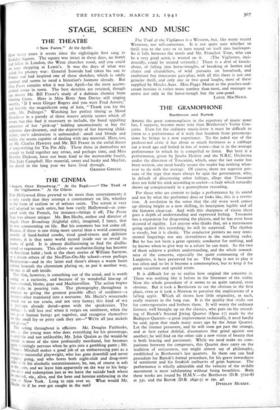THE GRAMOPHONE
Beethoven and Bartok AMONG the great commonplaces in the repertory of music none has, I suppose, become more trite than Beethoven's Violin Con- certo. Even for the ordinary music-lover it must be difficult to listen to a performance of it with that freedom from preconcep- tions he brings to a new experience. To the jaded eye of the professional critic it has about as much freshness as a cabbage cut a week ago and boiled in lots of water—that is in the average performance to which he is compelled to listen. But here is a performance, given by Jascha Heifetz and the N.B.C. Orchestra under the direction of Toscanini, which, once the last name has been written, one need hardly assure the reader has nothing what- ever to do with the average. Of course, there are superior per- sons of the type that must always be agin the government, who, in default of discovering other failings, allege that Toscanini does not hold his stick according to cocker—a fault which naturally shows up conspicuously in a gramophone recording.
For those who are content to judge a performance by its sound and not by what the performer does or looks like, this is a revela- tion. A revelation in the sense that the old worn work comes up shining bright as a new shilling, its inscription legible and all the features clear-cut. And with this sharpness of vision there goes a depth of understanding and expressed feeling. Toscanini has a reputation for dragooning the players, and he has even been accused of rigidity. Let anyone who thinks that, set a metronome going against this recording; he will be surprised. The rhythm is steady, but it is elastic. The conductor permits no easy senti- mental lingerings nor any slovenliness in the marching order. But he has not been a great operatic conductor for nothing, and he knows when to give way to a_ soloist he can trust. So the two of them achieve a perfect understanding, and the whole inward- ness of the concerto, especially the quiet communing of the Larghetto, is here preserved for us. The thing is not to play it too often and so let it become a commonplace, but to keep it for great occasions and special treats.
It is difficult for us to realise how original the concerto is. There was nothing like it before in the literature of the violin. Now the whole procedure of it seems to us quite natural, even obvious. But it took a Beethoven to see the obvious in the first place, even as it took a Newton to perceive the implications of a falling apple. Which all shows how little originality, as such, really matters in the long run. It is the quality that sticks out for contemporaries and bothers them. It will worry the ordinary listener, well brought up on the classics, who puts on the record- ing of Bartok's Second .tring Quartet (Opus x7) made by the Budapest Quartet—a great improvement technically, it need hardly be said, upon that made many years ago by the Amar Quartet. Let the listener persevere, and he will soon get past the strange, and at first rather doleful, dissonances that grind against one another; he will find on the other side a new vision of beauty that is both bracing and passionate. While we need make no com- parisons between the composers, this Quartet does carry on the tradition of seriousness, one might almost say of philosophy, established in Beethoven's last quartets. In them one can find precedent for Bartok's formal procedure, for his grave inwardness of sentiment and his freakish outbursts of grim humour. The performance is wholly admirable and the velocity of the middle movement is most exhilarating without being breathless. Both these works are issued by H.M.V.—the Beethoven (D.B. 5722-8) at 33s. and the Bartok (D.B. 2842-5) at 29s. 4d.
DYNELEY HUSSEY.






































 Previous page
Previous page